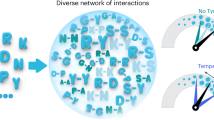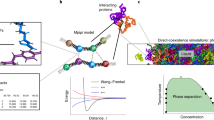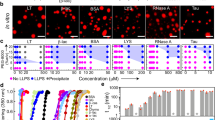Abstract
Understanding the intricate interactions governing protein and peptide behavior in liquid–liquid phase separation (LLPS) is crucial for unraveling biological functions and dysfunctions. This study employs a residue-leveled coarse-grained molecular dynamics approach to simulate the phase separation of repetitive polyproline and polyarginine peptides (poly PR) with varying lengths and sequences in solution, considering different concentrations and temperatures. Our findings highlight the crucial role of sequence order in promoting LLPS in peptides with identical lengths of repetitive sequences. Interestingly, repetitive peptides containing fewer than 10 polyarginine repeats exhibit no LLPS, even at salt concentrations up to 3 M. Notably, our simulations align with experimental observations, pinpointing a salt concentration of 2.7 M for PR25-induced LLPS. Utilizing the same methodology, we predict the required salt concentrations for LLPS induction as 1.2 M, 1.5 M, and 2.7 M for PR12, PR15, and PR35, respectively. These predictions demonstrate good agreement with experimental results. Extending our investigation to include the peptide glutamine and arginine (GR15) in DNA solution, our simulations mirror experimental observations of phase separation. To unveil the molecular forces steering peptide phase separation, we introduce a dielectric constant modifier and hydrophobicity disruptor into poly PR systems. Our coarse-grained analysis includes an examination of temperature effects, leading to the inference that both hydrophobic and electrostatic interactions drive phase separation in peptide systems.
Similar content being viewed by others
Introduction
Liquid–liquid phase separation (LLPS) is a prevalent and reversible phenomenon in biological systems, driven by the coordinated condensation of proteins and nucleic acids. This intricate process leads to the formation of membraneless cellular organelles (MLO) and plays crucial roles in physiological functions such as DNA repair1,2 and gene expression regulation3. Additionally, LLPS is implicated in the pathogenesis of diseases, including amyotrophic lateral sclerosis (ALS) and frontotemporal dementia (FTD)2,4. Recently study shows that some specific region containing sequence tendency for the Interaction between Low-Complexity Intrinsically Disordered Proteins is essential for LLPS5.
The thermodynamic process of LLPS involves proteins minimizing their free energy through weak interactions, resulting in the separation into dilute and concentrated phases. Balancing entropy and enthalpy forces is a complex challenge, driven by electrostatic and hydrophobic interactions, encompassing charge–charge, cation–π, dipole–dipole, and π–π molecular interactions6.
Recently, several coarse-grained simulations have shed light on various aspects of Liquid–Liquid Phase Separation (LLPS). These include the dynamics surrounding lipopolysaccharide (LPS)-containing outer membranes7, as well as the modeling of disordered biomolecules for LLPS simulations8. The advantages of employing simple coarse-grained models have been further examined and contrasted with LLPS propensities9. Moreover, there has been significant progress in develo** a transferable coarse-grained model to evaluate the impact of Post-Translational Modifications (PTMs) on LLPS within a computational simulation framework10.
Repetitive peptides involved in LLPS are not only implicated in LLPS itself but also play crucial roles in various biological functions. A significant illustration of this is found in the identification of C9ORF72 as a causal gene for familial amyotrophic lateral sclerosis and frontotemporal dementia11,12. The mutations of C9ORF72 are prevalent in both genetic forms of these debilitating diseases12. Patients with C9ORF72 mutations exhibit expanded six-nucleotide repeats, activating unconventional translation mechanisms and producing dipeptide repeat proteins, including poly PR and poly GR, known for their notable toxicity in cellular and animal models13,14,15.
In our present study, we employ MD simulations to investigate the effects of LLPS on peptide polymerization length, salt concentration, and temperature. Experimental settings include the introduction of dielectric constant modifiers and hydrophobic disruptors to modify the interaction between poly-PR7.
Continuing our analysis, we delve deeper into the phase separation behavior of PR15. Figure 8 displays the LLPS behavior of PR15 at different hydrophobic values of arginine. In Fig. 8a, PR15 is depicted at 2700 mM, where its proline and arginine hydro-phobic values are set to λ = 1.0 and λ = 0.9, respectively. Moving to Fig. 8b, we observe the impact of altering the arginine hydrophobic value to 0.6 while maintaining the proline hydrophobic value constant. Figure 8c illustrates that a further reduction in the arginine hydrophobic value to 0.5 results in the complete dissolution of the PR15 aggregate, effectively destroying the phase separation. This outcome underscores the pivotal role of hydrophobic interactions in the LLPS of PR peptides. In our simulation, we disrupted phase separation by diminishing the hydrophobic value of arginine, mirroring real-world experiments where phase-separated solutions were disrupted by introducing hydrophobic disruptors11.
Figure 11 shows the LLPS behavior of poly PR with a total of 15 amino acids under different amino acid sequences. Experimental findings revealed that different sequences of proline–arginine exhibited distinct degrees of aggregation. With a fixed quantity of arginine, increasing the separation of prolines resulted in a more pronounced aggregation effect. Similarly, for the same total number of proline-arginine repeats, the outcomes varied significantly based on the location of arginine.
To delve deeper into the influence of amino acid sequence on phase separation, we simulated the phase separation results of different amino acid sequences of PR12 at a concentration of 1200 mM. Figure 12 shows the LLPS behavior of poly PR with a total of 12 amino acids under different amino acid sequences. The simulation results showed that a smaller number of proline-arginine repeats led to a more evident aggregation effect.
Simulation and experimental verification of phase separation of GR15 and salmon sperm DNA
Additionally, to validate the reliability of the simulation program, we simulated the phase separation behavior of GR15 with single-stranded DNA, which bears an extremely similar composition to PR15. Subsequently, we conducted experimental verification. All reagents and chemicals were procured in the highest purity. Tris base was purchased from Sigma-Aldrich, and the Gly-Arg repeat sequence (GR15) was obtained in freeze-dried powder form from Jiangsu Jitaipeptide Industry Technology Co., Ltd. (Suzhou, China, Lot. No.: P231120-MX432173). Oligonucleotides (i.e., salmon sperm DNA) were obtained in dry form from Thermo Fisher Science US Inc., and purified water was acquired from the Milli-Q system.
The phase separation of GR15 with salmon sperm DNA was observed using a Nikon Ti-E inverted microscope equipped with a Nikon 50× oil-immersion objective (Nikon CFI Apo 50XW NIR) and a 48MP FHD Camera V8. As salmon sperm DNA carries a negative charge, glycine in GR15 is uncharged, and arginine carries a positive charge, we assumed that the mixed solution of GR15 and salmon sperm neutralized the electrostatic charges, canceling out the arginine charge.
As shown in Fig. 13, we simulated mixed solutions of salmon sperm with GR15 at concentrations of 0.25 μg/μl, 0.5 μg/μl, and 1 μg/μl, corresponding to calculated ionic strengths of 0.24 M, 0.48 M, and 0.95 M, respectively. The results demonstrated phase separation in all cases, with more prominent phase separation observed as the salmon sperm concentration increased. Figure 14 illustrates the experimental verification, wherein the droplets of phase-separated condensate became larger with an increase in salmon sperm DNA concentration. The experimental results are in substantial agreement with the simulation results, affirming the feasibility of our phase separation simulation program.
Conclusions
In our comprehensive exploration, we delved into the LLPS behavior of poly-proline-arginine under different salt concentrations and temperatures, elucidating the roles of hydrophobic and electrostatic interactions in LLPS. Our key findings are summarized below:
-
Threshold for LLPS LLPS behavior in PR peptides is observable only when the concentration surpasses 1000 mM, with the required salt concentration for LLPS escalating with sequence length. PR peptides with a repeat sequence of fewer than 10 did not manifest LLPS at any salt concentration. The occurrence of phase separation of PR peptides is only related to salt concentration and their length, and changes in the quantity of PR peptides do not affect the results of phase separation.
-
Influence of Interactions Both hydrophobic and electrostatic interactions contribute to the LLPS behavior of PR peptides. Hydrophobic interaction exerts a significant impact, while electrostatic interaction plays a comparatively smaller role. In PR peptides exhibiting LLPS, reducing their hydrophobic value weakens or even eliminates LLPS, promoting homogeneity.
-
Temperature Impact Temperature also influences the LLPS behavior of PR peptides. An increase in temperature leads to a decrease in the aggregation of PR15, and at 340 K, aggregation disappears, disrupting the LLPS behavior of PR15.
-
Sequence Variation Different proline-arginine sequences in poly PR result in varying degrees of phase separation, emphasizing the significance of amino acid sequence in LLPS.
-
Program Validation: Simulation and experimental verification of GR15 with salmon sperm DNA confirmed the program’s capability to predict phase separation behavior.
In conclusion, our simulation outcomes offer novel insights and methodologies for further understanding the potential mechanisms of LLPS. These findings may serve as a foundation for exploring innovative treatment strategies and drug development for diseases associated with phase separation phenomena.
Data availability
The data that support the findings of this study are available from the corresponding author, G. Y., upon reasonable request.
References
Altmeyer, M. et al. Liquid demixing of intrinsically disordered proteins is seeded by poly(ADP-ribose). Nat. Commun. https://doi.org/10.1038/ncomms9088 (2015).
Patel, A. et al. A liquid-to-solid phase transition of the ALS protein FUS accelerated by disease mutation. Cell 162, 1066–1077. https://doi.org/10.1016/j.cell.2015.07.047 (2015).
Hnisz, D., Shrinivas, K., Young, R. A., Chakraborty, A. K. & Sharp, P. A. A phase separation model for transcriptional control. Cell 169, 13–23. https://doi.org/10.1016/j.cell.2017.02.007 (2017).
Mateju, D. et al. An aberrant phase transition of stress granules triggered by misfolded protein and prevented by chaperone function. EMBO J. 36, 1669–1687. https://doi.org/10.15252/embj.201695957 (2017).
Zhang, M. et al. Sequence tendency for the interaction between low-complexity intrinsically disordered proteins. JACS Au 3, 93–104. https://doi.org/10.1021/jacsau.2c00414 (2022).
Krainer, G. et al. Reentrant liquid condensate phase of proteins is stabilized by hydrophobic and non-ionic interactions. Nat. Commun. https://doi.org/10.1038/s41467-021-21181-9 (2021).
Jiang, X. et al. Coarse-grained simulations uncover Gram-negative bacterial defense against polymyxins by the outer membrane. Comput. Struct. Biotechnol. J. 19, 3885–3891 (2021).
Benayad, Z., von Bülow, S. R., Stelzl, L. S. & Hummer, G. Simulation of FUS protein condensates with an adapted coarse-grained model. J. Chem. Theory Comput. 17, 525–537 (2020).
Das, S., Amin, A. N., Lin, Y.-H. & Chan, H. S. Coarse-grained residue-based models of disordered protein condensates: Utility and limitations of simple charge pattern parameters. Phys. Chem. Chem. Phys. 20, 28558–28574 (2018).
Perdikari, T. M. et al. A predictive coarse-grained model for position-specific effects of post-translational modifications. Biophys. J. 120, 1187–1197 (2021).
DeJesus-Hernandez, M. et al. Expanded GGGGCC hexanucleotide repeat in noncoding region of C9ORF72 causes chromosome 9p-linked FTD and ALS. Neuron 72, 245–256 (2011).
Renton, A. E. et al. A hexanucleotide repeat expansion in C9ORF72 is the cause of chromosome 9p21-linked ALS-FTD. Neuron 72, 257–268 (2011).
Zu, T. et al. Non-ATG-initiated translation directed by microsatellite expansions. Proc. Natl. Acad. Sci. 108, 260–265 (2011).
Mori, K. et al. The C9orf72 GGGGCC repeat is translated into aggregating dipeptide-repeat proteins in FTLD/ALS. Science 339, 1335–1338 (2013).
Mori, K. et al. Bidirectional transcripts of the expanded C9orf72 hexanucleotide repeat are translated into aggregating dipeptide repeat proteins. Acta Neuropathol. 126, 881–893 (2013).
Wang, Y., **ang, D., Chen, S. & Yang, G. Comprehensive regulation of liquid–liquid phase separation of polypeptides. Molecules 28, 6707 (2023).
Dignon, G. L., Zheng, W., Kim, Y. C., Best, R. B. & Mittal, J. Sequence determinants of protein phase behavior from a coarse-grained model. PLoS Comput. Biol. 14, e1005941 (2018).
Kroschwald, S., Maharana, S. & Simon, A. Hexanediol: A chemical probe to investigate the material properties of membrane-less compartments. Matters. https://doi.org/10.19185/matters.201702000010 (2017).
Tesei, G., Schulze, T., Crehuet, R. & Lindorff-Larsen, K. Accurate model of liquid–liquid phase behaviour of intrinsically-disordered proteins from data-driven optimization of single-chain properties. BioRxiv 11, 1–9 (2021).
Regy, R. M., Thompson, J., Kim, Y. C. & Mittal, J. Improved coarse-grained model for studying sequence dependent phase separation of disordered proteins. Protein Sci. 30, 1371–1379 (2021).
Dannenhoffer-Lafage, T. & Best, R. B. A data-driven hydrophobicity scale for predicting liquid–liquid phase separation of proteins. J. Phys. Chem. B 125, 4046–4056 (2021).
Dumetz, A. C., Chockla, A. M., Kaler, E. W. & Lenhoff, A. M. Protein phase behavior in aqueous solutions: Crystallization, liquid–liquid phase separation, gels, and aggregates. Biophys. J. 94, 570–583 (2008).
Alberti, S., Gladfelter, A. & Mittag, T. Considerations and challenges in studying liquid–liquid phase separation and biomolecular condensates. Cell 176, 419–434 (2019).
Kanekura, K., Hayamizu, Y. & Kuroda, M. Order controls disordered droplets: Structure–function relationships in C9ORF72-derived poly (PR). Am. J. Physiol. Cell Physiol. 322, C197–C204 (2022).
Funding
This work is supported by the National Natural Science Foundation of China (12074289), Natural Science Foundation of Zhejiang Province (Y23A040004).
Author information
Authors and Affiliations
Contributions
Conceptualization, Guangcan Yang and **aojun Yang; investigation, **aojun Yang, Yanwei Wang and Guangcan Yang; data curation, **aojun Yang; writing—original draft preparation, **aojun Yang and Guangcan Yang; writing—review and editing, Guangcan Yang. All authors have read and agreed to the published version of the manuscript.
Corresponding authors
Ethics declarations
Competing interests
The authors declare no competing interests.
Additional information
Publisher's note
Springer Nature remains neutral with regard to jurisdictional claims in published maps and institutional affiliations.
Rights and permissions
Open Access This article is licensed under a Creative Commons Attribution 4.0 International License, which permits use, sharing, adaptation, distribution and reproduction in any medium or format, as long as you give appropriate credit to the original author(s) and the source, provide a link to the Creative Commons licence, and indicate if changes were made. The images or other third party material in this article are included in the article's Creative Commons licence, unless indicated otherwise in a credit line to the material. If material is not included in the article's Creative Commons licence and your intended use is not permitted by statutory regulation or exceeds the permitted use, you will need to obtain permission directly from the copyright holder. To view a copy of this licence, visit http://creativecommons.org/licenses/by/4.0/.
About this article
Cite this article
Yang, X., Wang, Y. & Yang, G. Molecular dynamics simulation on regulation of liquid–liquid phase separation of repetitive peptides. Sci Rep 14, 13382 (2024). https://doi.org/10.1038/s41598-024-64327-7
Received:
Accepted:
Published:
DOI: https://doi.org/10.1038/s41598-024-64327-7
- Springer Nature Limited









